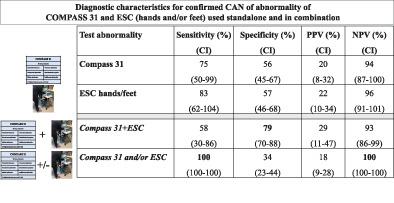当前位置:
X-MOL 学术
›
J. Peripher. Nerv. Syst.
›
论文详情
Our official English website, www.x-mol.net, welcomes your
feedback! (Note: you will need to create a separate account there.)
The diagnostic usefulness of the combined COMPASS 31 questionnaire and electrochemical skin conductance for diabetic cardiovascular autonomic neuropathy and diabetic polyneuropathy.
Journal of the Peripheral Nervous System ( IF 3.9 ) Pub Date : 2020-02-14 , DOI: 10.1111/jns.12366 Cinzia D'Amato 1 , Carla Greco 1 , Giorgio Lombardo 1 , Valentina Frattina 1 , Mariagrazia Campo 1 , Chiara M A Cefalo 1 , Valentina Izzo 1 , Davide Lauro 1 , Vincenza Spallone 1
Journal of the Peripheral Nervous System ( IF 3.9 ) Pub Date : 2020-02-14 , DOI: 10.1111/jns.12366 Cinzia D'Amato 1 , Carla Greco 1 , Giorgio Lombardo 1 , Valentina Frattina 1 , Mariagrazia Campo 1 , Chiara M A Cefalo 1 , Valentina Izzo 1 , Davide Lauro 1 , Vincenza Spallone 1
Affiliation

|
The study investigated the diagnostic performance for diabetic cardiovascular autonomic neuropathy (CAN) and diabetic polyneuropathy (DPN) of the combined use of composite autonomic symptom score (COMPASS) 31, validated questionnaire for autonomic symptoms of CAN, and electrochemical skin conductance (ESC), proposed for detecting DPN and CAN. One‐hundred and two participants with diabetes (age 57 ± 14 years, duration 17 ± 13 years) completed the COMPASS 31 before assessing cardiovascular reflex tests (CARTs), neuropathic symptoms, signs, vibratory perception threshold (VPT), thermal thresholds (TT), and ESC using Sudoscan. Two patterns were evaluated: (a) the combined abnormalities in both tests (COMPASS 31+ESC), and (b) the abnormality in COMPASS 31 and/or ESC (COMPASS 31 and/or ESC). CAN (≥1 abnormal CART) and confirmed CAN (≥2 abnormal CARTs) were present in 28.1% and 12.5%, DPN (two abnormalities among symptoms, signs, VPT, and TT) in 52%, abnormal COMPASS 31 (total weighted score >16.44) in 48% and abnormal ESC (hands ESC <50 μS and/or feet ESC <70 μS) in 47.4%. Both the patterns—COMPASS 31+ESC and COMPASS 31 and/or ESC—were associated with CAN and DPN (P < .01). COMPASS 31 and ESC reached a sensitivity of 75% and 83% for confirmed CAN, and a specificity of 65% and 67% for DPN. When combining the tests, the sensitivity for CAN rose by up to 100% for CAN and the specificity up to 89% for DPN. The combination of the tests can allow a stepwise screening strategy for CAN, by suggesting CAN absence with combined normality, and prompting to CARTs with combined abnormality.
中文翻译:

结合COMPASS 31问卷和电化学皮肤电导率对糖尿病性心血管自主神经病变和糖尿病性多发性神经病的诊断价值。
这项研究调查了对糖尿病性心血管自主神经病(CAN)和糖尿病性多发性神经病(DPN)的诊断性能,并结合了复合自主神经症状评分(COMPASS)31,经过验证的CAN自主神经症状问卷和电化学皮肤电导(ESC)建议用于检测DPN和CAN。一百零二名糖尿病患者(年龄57±14岁,病程17±13岁)在评估心血管反射测试(CART),神经性症状,体征,振动知觉阈值(VPT),热阈值(TT)之前完成了COMPASS 31 ),然后使用Sudoscan进行ESC。评估了两种模式:(a)两种测试的综合异常(COMPASS 31 + ESC),以及(b)COMPASS 31和/或ESC(COMPASS 31和/或ESC)的异常)。CAN(≥1异常CART)和已确认的CAN(≥2异常CART)占28.1%和12.5%,DPN(症状,体征,VPT和TT中两个异常)占52%,COMPASS 31异常(加权总分) > 16.44)占48%,异常ESC(手ESC <50μS和/或脚ESC <70μS)占47.4%。两种模式-COMPASS 31 + ESC和COMPASS 31和/或ESC-均与CAN和DPN(P <.01)。COMPASS 31和ESC对已确认的CAN的敏感性分别达到75%和83%,对DPN的特异性分别为65%和67%。结合测试后,CAN的灵敏度对CAN最高提高了100%,而DPN的特异性高达89%。这些测试的组合可以通过建议CAN缺失和正常组合,并提示具有异常组合的CART来逐步检查CAN。
更新日期:2020-02-14
中文翻译:

结合COMPASS 31问卷和电化学皮肤电导率对糖尿病性心血管自主神经病变和糖尿病性多发性神经病的诊断价值。
这项研究调查了对糖尿病性心血管自主神经病(CAN)和糖尿病性多发性神经病(DPN)的诊断性能,并结合了复合自主神经症状评分(COMPASS)31,经过验证的CAN自主神经症状问卷和电化学皮肤电导(ESC)建议用于检测DPN和CAN。一百零二名糖尿病患者(年龄57±14岁,病程17±13岁)在评估心血管反射测试(CART),神经性症状,体征,振动知觉阈值(VPT),热阈值(TT)之前完成了COMPASS 31 ),然后使用Sudoscan进行ESC。评估了两种模式:(a)两种测试的综合异常(COMPASS 31 + ESC),以及(b)COMPASS 31和/或ESC(COMPASS 31和/或ESC)的异常)。CAN(≥1异常CART)和已确认的CAN(≥2异常CART)占28.1%和12.5%,DPN(症状,体征,VPT和TT中两个异常)占52%,COMPASS 31异常(加权总分) > 16.44)占48%,异常ESC(手ESC <50μS和/或脚ESC <70μS)占47.4%。两种模式-COMPASS 31 + ESC和COMPASS 31和/或ESC-均与CAN和DPN(P <.01)。COMPASS 31和ESC对已确认的CAN的敏感性分别达到75%和83%,对DPN的特异性分别为65%和67%。结合测试后,CAN的灵敏度对CAN最高提高了100%,而DPN的特异性高达89%。这些测试的组合可以通过建议CAN缺失和正常组合,并提示具有异常组合的CART来逐步检查CAN。











































 京公网安备 11010802027423号
京公网安备 11010802027423号